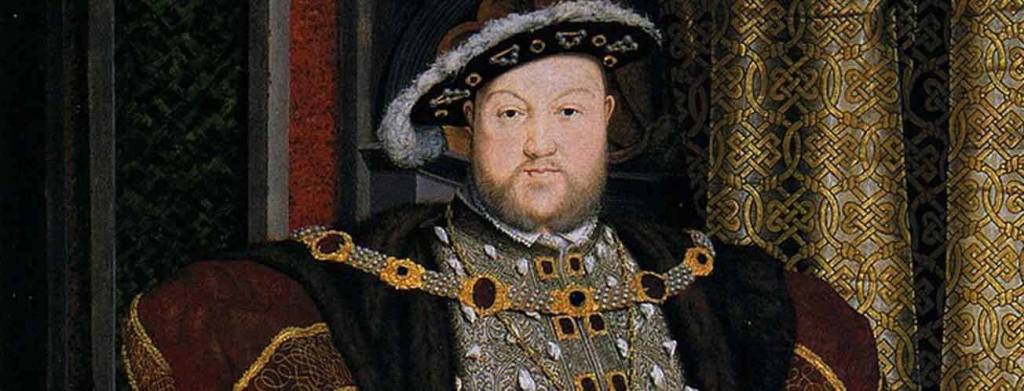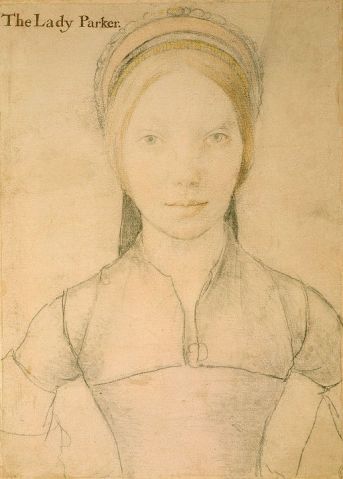Christmas at the court of Henry VIII by Alison Weir

Henry VIII always kept the feast of Christmas with ‘much nobleness and open court’. It was incumbent upon kings to dispense hospitality throughout the twelve days of the festival, and in Henry’s reign more than a thousand people dined at court during the Yuletide season, and an Italian visitor noted that on one occasion the guests remained at table for over seven hours.
All meats were carried into the dining hall with ceremony; far from confirming to the chicken-throwing image of Henry VIII popularised by Charles Laughton, the table manners of the King and his courtiers were refined and decorous – apart from the time when Henry got bored and began pelting his guests with sugar plums. As for desserts, there might be twenty sorts of jellies in the shape of castles or animals. Frumenty – a mixture of wheat or corn boiled in milk with fruit and even meat – was extremely popular, and would one day evolve into our Christmas pudding.
Turkey arrived in England in around 1540, but it would be centuries before it ousted the traditional boar’s head, peacock, swan, larks, partridges, quails, roast beef and prawn pasties. Roast peacock was served in its plumage, while the boar’s head was dressed with herbs and had an apple in its mouth. As the wild boar gradually became extinct, its presence at the Yuletide feast was increasingly reserved for noblemen who could afford to fit out a hunting party to track down and kill the elusive beast. Thus, by Tudor times, the boar’s head was a status symbol. Wynkin de Worde’s Christmasse Carolles, published in 1521, is the earliest recorded printed collection, and includes the famous ‘Boar’s Head Carol’, which describes the ancient tradition of sacrificing a boar and presenting its head at a Yuletide feast, ‘bedecked with bay and rosemary’.
Henry VIII liked to keep Christmas at Greenwich Palace, his birthplace. Hampton Court was also favoured by the Tudor monarchs and the palace would be specially decorated for the Christmas period. Greenery of the season, along with dried fruit, berries, and candles constituted the bulk of Tudor Christmas decorations.
The court was always full at Christmas, and the public were often allowed in to watch the ‘goodly and gorgeous mummeries’ – usually from a safe distance – and to partake of the festive fare on offer. In the great hall or presence chamber, the mighty Yule log crackled on the hearth, and carols were sung and danced. The Advent fast ended on Christmas Eve; then there were twelve days of feasting, banqueting, pageantry, disguising, and convivial merrymaking, all presided over by the Lord of Misrule, or Master of Merry Disports, who acted as master of ceremonies. Adorned with scarves, ribbons, laces, jewels and bells, he had a train of heralds, magicians, and fools in fancy dress. He was solemnly crowned, and could choose servants to wait upon him. This was a time when rank took second place to revelry. Even the King had to obey the commands of the Lord of Misrule. Will Wynesbury was Lord of Misrule in the first year of Henry VIII’s reign, and impudently asked his sovereign for five pounds towards his expenses, which amused Henry inordinately.
Traditionally, on Christmas Eve, mummers would perform a play depicting St George and the Dragon. Pageants, masques, interludes, plays, music and disguisings, mostly devised under the direction of the Master of the Revels, carried on throughout the twelve days of Christmas. The children of the Chapel Royal would come before the monarch and sing carols. Board games such as chess or backgammon were popular, as were cards and dice. These games were organised by the Knight Marshal of the Household.
Christmas at the Tudor court was a time for solemn religious observances as well as dancing, singing and plays. Each Christmas Day Henry VIII would hear Mass in his closet before going in procession to the Chapel Royal for Matins, where he himself participated in the service. A solemn feast in honour of the Nativity would follow. Henry passed a law banning all sports on Christmas Day except archery, which was seen as essential to maintaining the country’s military strength.
Presents were exchanged, not on Christmas Day, but on New Year’s Day when every courtier and servant gave the monarch a present, and – if they were privileged – received a gift in return. Each gift was presented by the donor in a glittering ceremony in the presence chamber, where the gifts – which were usually gold or silver plate, jewellery or money – were afterwards listed and displayed on sideboards or trestle tables for all to see. At court, gift giving was of great political significance. If the King accepted your gift you were held in favour, but if they were rejected things were not looking good. In 1532 Henry VIII accepted gifts from Anne Boleyn but rejected gifts from his queen, Katherine of Aragon.
For the sumptuous banquet that marked Twelfth Night, a special cake was baked. The cake contained a pea or a bean; whoever found it would be king or queen for the evening and lead the singing, dancing or disports. On Twelfth Night the wassail cup containing spiced ale was brought in by the Lord Steward and presented to the King and Queen and then passed around the table.
Henry VIII loved disguisings. At Twelfth Night in 1510, he ‘came to Westminster with the Queen, and being there the King, the Earls of Essex, Wiltshire and other noblemen came suddenly in a morning into the Queen’s chamber, all apparelled in short coats of Kentish Kendal, with hoods on their heads, and bows and arrows, like outlaws or Robin Hood’s men, whereof the Queen and the ladies were abashed, as well for the strange sight, as also for their sudden coming, and after dances and pastime made, they departed. Later at dinner the King arranged the seating and joked with all, and had the Earl of Essex, the Lord Henry, Earl of Wiltshire, Sir Edward Howard and Sir Thomas Parr parade in strange costumes before they brought in actors to stage a play’.
A Tudor Christmas was just starting to resemble something that we, in the twenty-first century, might recognise, even if there were some aspects that would seem strange to us. But Tudor England was still many years away from Christmas cards, Christmas turkey, Christmas crackers, Father Christmas and Christmas trees.
KATHERYN HOWARD: THE TAINTED QUEEN by Alison Weir, the fifth book in the Six Tudor Queens series, is out now. You can find out more on the Six Tudor Queens website.






